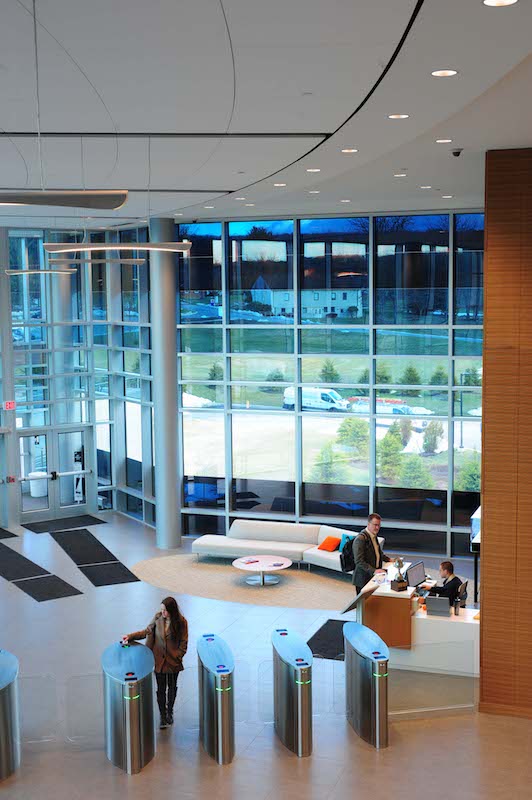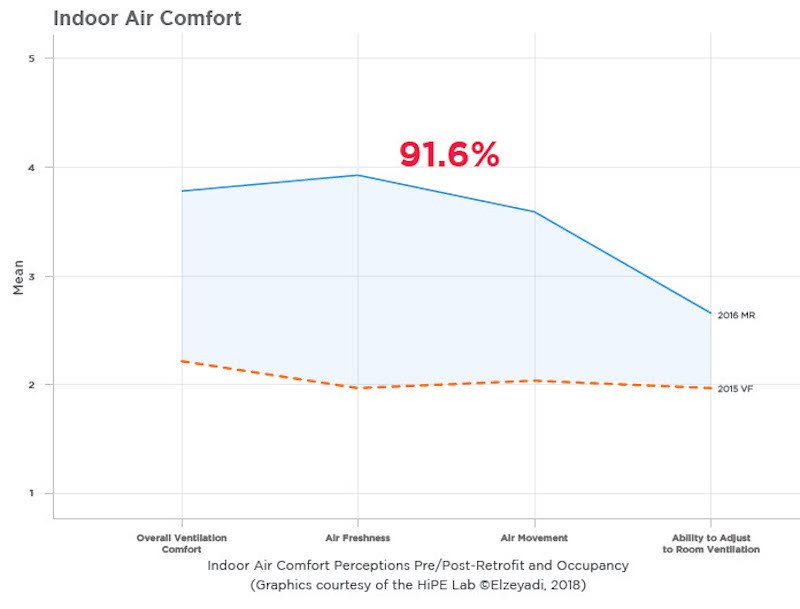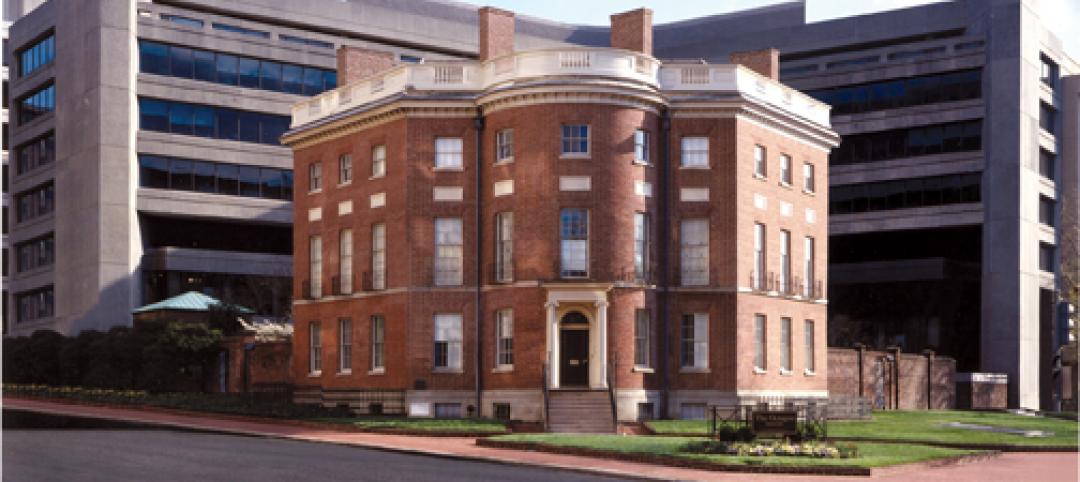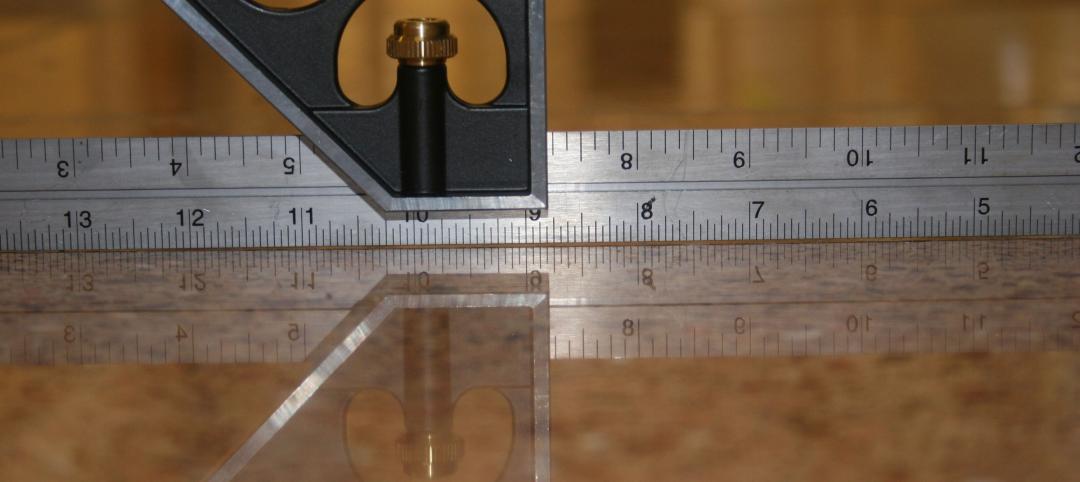Saint Gobain, the giant building materials supplier, has released the results of a three-year-long study that compared occupant comfort for the 800 employees at its old headquarters in Valley Forge, Pa., with the comfort levels for those same employees after they moved into the company’s new 277,000-sf North American headquarters in Malvern, Pa., which opened in October 2015.
That new LEED Platinum-certified building—an adaptive reuse of an office building that entailed 85% renovation and 15% new construction—is a “living laboratory” for Saint Gobain’s current and newly created products. The headquarters also showcases more than 60 innovative technologies.
The four-phase study, buttressed by a 76-question employee survey, found significant improvements in employees’ perceptions about indoor air quality, visual comfort, and acoustic comfort as a result of Saint Gobain’s “multi-comfort design approach” that combines sustainability, aesthetics, and comfort to improve occupant well-being. However, improving thermal comfort proved to be a harder nut to crack.
The study’s results are informing Saint Gobain’s new 30-story worldwide headquarters under construction in Paris.
Saint Gobain “wants to be the leader in habitat” by aggressively promoting its multi-comfort approach, says Stanley Gatland II, Manager of Building Sciences and Comfort for the company’s CertainTeed division. “We want to make occupant outcomes part of the conversation” with customers, adds Lucas Hamilton, CertainTeed’s Manager of Building Science Applications.
Four-step process
To evaluate the impact and efficacy of multi-comfort design elements in the new headquarters, Saint-Gobain partnered with a group of experts led by Dr. Ihab Elzeyadi, Director of the University of Oregon’s High Performance Environments (HiPE) Lab, to conduct an extensive four-phase comparative analysis of Indoor Environmental Quality (IEQ).
In the first phase of the study, a research team inspected the existing unoccupied Malvern facility prior to its adaptive renovation and reuse. In the second phase, the team examined the former Saint-Gobain headquarters in Valley Forge, to establish a benchmark for the performance of the new headquarters. In phase three, the team analyzed the new headquarters following envelope upgrades and interior design retrofits, but prior to occupancy. Finally, the fourth phase of the study assessed the newly completed Malvern headquarters post-occupancy.
Employees were questioned while they still worked at Valley Forge, as well in the fall of 2016 and 2017, after they had settled into the new headquarters. The questionnaires touched on 30 issues pertaining to workspace characteristics, indoor environment quality, comfort of ambient quality, health and well being, and productivity.

Electrochromic SageGlass on the building's southern and western facades contributed to employees' improved visual comfort. Image: Saint Gobain
The visual comfort parameter focused on daylighting and, more specifically, the relative impact of installing Saint Gobain’s SageGlass on the building’s western and southern façades. That electrochromic glazing provides three levels of tinting that are selected automatically in response to system programming and the changing light conditions throughout the day. These are detected by sensors on the roof of the building. The brightness of interior LED luminaires is similarly controlled according to incoming daylight.
In the old headquarters, less than half of the employees had access to daylight; in the new building, 92%. Only 4% of individuals now lack access to outside windows at their workspaces, compared to 23% at the former headquarters.
Unsurprisingly, employees reported a 56.4% overall improvement in visual comfort in the new headquarters, including gains of 30% to 60% in each of the following categories: overall lighting comfort, amount of light for working, glare from electric lights, ability to adjust to electric light, amount of daylight, glare from windows and the ability to adjust window shades.
To evaluate thermal comfort, Saint Gobain invested in significant upgrades to the new building’s core and envelope during renovation, including improved insulation, solar-reflective roofing, high-efficiency glazing, argon-gas-filled insulated glass, aluminum curtain wall systems and high-performance heating and cooling equipment.
The research team calculated thermal comfort conditions in accordance with ANSI/ASHRAE Standard 55-2013 and used electronic sensors over a long period of time to collect data on temperature, relative humidity, air velocity, globe temperature and air movement across various micro-climates in the Malvern facility.
Employees reported only a 4.8% improvement in thermal comfort in the new headquarters compared to the old. At key points during summer months, residents found themselves shifting from overly air-conditioned environments to hot, humid ones over a span of just a few hours.
Hamilton points out that the developer of the new headquarters (which wasn’t Saint Gobain) insisted on repurposing as much of the Malvern office structure as possible, including its mechanicals. Consequently, the HVAC system wasn’t always rightsized for a new headquarters with 116 collaborative spaces. Hamilton believes that thermal comfort results would be “a lot better” in projects that are completely new construction or have more extensive renovations.
“One lesson we learned was to spend more time reviewing whether to retain or replace existing building systems, especially when an extensive renovation will fundamentally change how a building will perform,” Saint Gobain stated in its report on the study.
Better results for acoustics and air quality
The study found much greater success in improving acoustic and indoor air quality. For acoustic comfort, the new headquarters was designed with sound-absorbing surfaces, high-performance interior partitions and exterior facades, isolating vibrating components in the HVAC system, and equipped with white noise machines to mask sound and manage speech intelligibility.
Saint Gobain also mapped the building’s sound absorption, sound levels, and workstation distraction distances to evaluate the effectiveness of its acoustic comfort tactics. It achieved a 42.2% improvement in employee perceptions.

Employees' perceptions of the new headquarters' indoor air quality were significantly higher than how they felt about their old workplace. Image: Saint Gobain
The new building’s air quality was monitored along seven discrete facets of design: outdoor air ventilation, particulate filtration, dehumidification, moisture flow management, air leakage control, Volatile Organic Compound (VOC) control, and contaminant capture.
The design included two wall covering products: one with the ability to trap and neutralize 70% of harmful aldehydes, and another designed with an antimicrobial coating that actively repels and kills fungus and black mold. Drywall tape had mold- and mildew-resistant properties. Backerboard was moisture and mold resistant. Wallboard and ceilings absorbed and converted formaldehyde a safe, inert compound.
The result: a 91.6% improvement in employee perceptions about indoor air quality. “A week after moving into the [Malvern] building, some employees thought we were pumping oxygen into the building,” recalls Hamilton.
Overall, employees reported that levels of visual, acoustical and indoor air quality comfort were 26.3% greater on average at the Malvern facility than at Valley Forge. Additionally, occupants’ satisfaction with indoor environmental quality (a measurement composed of employees’ ratings of temperature, lighting quality, acoustics, air quality, smell, ergonomics and space function) improved by 47.9% in the new space.
Does employee comfort translate to better productivity? Maybe. Saint Gobain compared the performance of its internal sales team in its last week in Valley Forge with its first week in Malvern. The team fielded the same number of calls in both weeks, but qualified leads jumped by 150%, and sales in the latter week were $5.6 million higher.
Related Stories
| Nov 17, 2011
Hollister Construction Services renovating bank in Union City, N.J.
Project is part of a series of ground-up construction and renovation assignments.
| Nov 16, 2011
Project completion of BRAC 132, Office of the Chief Army Reserve Building, Ft. Belvoir, Va.
This fast-tracked, design-build project consists of a three-story, 88,470 sf administrative command building housing approximately 430 employees.
| Nov 15, 2011
Struggling economy demands construction industry embrace enterprise-wide risk management
In today’s business environment of high supply and limited demand, it has become especially vital for organizations in the construction sector to effectively manage risk.
| Nov 15, 2011
Miller joins Perkins Eastman as regional manager, Middle East and Northern Africa
Miller joins Perkins Eastman with more than 48 years of experience in architecture, design management, and construction administration for planning and infrastructure.
| Nov 14, 2011
VanSumeren appointed to Traco general manager
VanSumeren will draw on his more than 20 years of experience in manufacturing management and engineering to deliver operational and service excellence and drive profitable growth for Traco.
| Nov 11, 2011
By the Numbers
What do ‘46.9,’ ‘886.2,’ and ‘171,271’ mean to you? Check here for the answer.
| Nov 11, 2011
AIA: Engineered Brick + Masonry for Commercial Buildings
Earn 1.0 AIA/CES learning units by studying this article and successfully completing the online exam.
| Nov 11, 2011
How Your Firm Can Win Federal + Military Projects
The civilian and military branches of the federal government are looking for innovative, smart-thinking AEC firms to design and construct their capital projects. Our sources give you the inside story.
| Nov 10, 2011
Thornton Tomasetti’s Joseph and Choi to co-chair the Council on Tall Buildings and Urban Habitat’s Outrigger Design Working Group
Design guide will describe in detail the application of outriggers within the lateral load resisting systems of tall buildings, effects on building behavior and recommendations for design.
| Nov 8, 2011
WEB EXCLUSIVE: Moisture-related failures in agglomerated floor tiles
Agglomerated tiles offer an appealing appearance similar to natural stone at a lower cost. To achieve successful installations, manufacturers should provide design data for moisture-related dimensional changes, specifiers should require in-situ moisture testing similar to those used for other flooring materials, and the industry should develop standards for fabrication and installation of agglomerated tiles.














